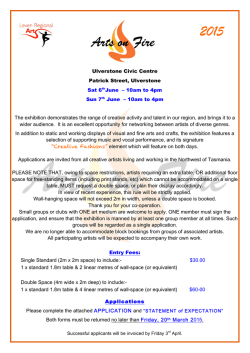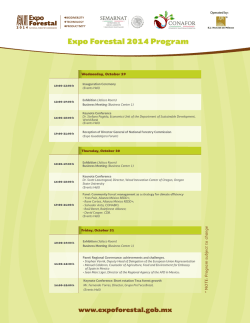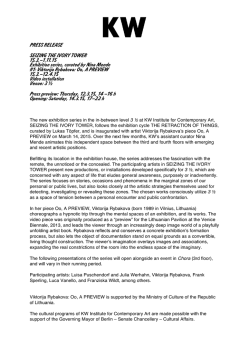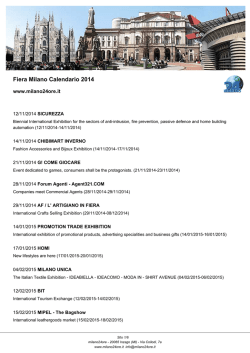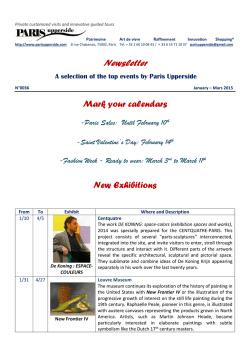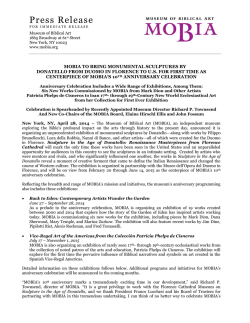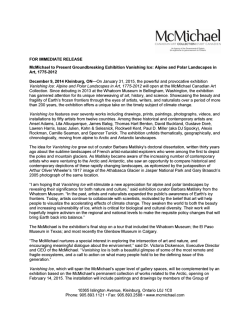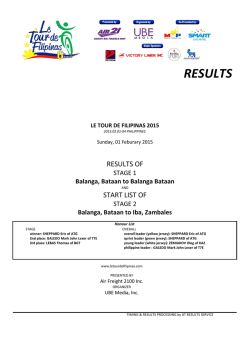
Press Pack Canibalia - Accion Cultural Española
KADIST ART FOUNDATION PARIS Press Pack Design : Rifle Canibalia With Theodor de Bry, Jeleton, Runo Lagomarsino, Candice Lin, Pablo Marte, Carlos Motta, Pedro Neves Marques, Manuel Segade, Daniel Steegmann Mangrané. Curated by Julia Morandeira Arrizabalaga From February 6 to April 26, 2015 Opening reception on Friday, February 6, from 6 to 9 pm Press breakfast and tour of the exhibition with the curator: Friday, February 6, from 9.30 to 11am Kadist Art Foundation, Paris - 19 bis-21 rue des Trois Frères - F-75018 - Tél. +33 1 42 51 83 49 - www.kadist.org Canibalia is a research and exhibition project curated by Julia Morandeira Arrizabalaga around the figure and notion of the cannibal. Gathering artists from North and South America, Portugal and Spain, the exhibition will entail a visual exploration on the anthropophagic subject. The cannibal is a quite recent invention. Its first mention dates back to Columbus’ initial American trip in 1492, when he hears from the indigenous people of a bellicose tribe inhabiting the southern islands of the Caribbean archipelago, “which had just one eye, a dog face” and were man-eaters; these were referred to as carib and caniba. Beyond naming the anthropophagous monster, as well as the geographical area it inhabits, the anecdote of the creation of the term resumes well the colonial, modern and capitalist crucible in which the cannibal was constructed. It defined an unstable and speculative imaginary, subject and territory in which renewed spectres of alterity, cultural anxieties and imperial interests converged. In fact, being sacrificed, cut into pieces, butchered and devoured appears as the most recurrent fear in Europe’s imagination of America, thus multiplying the meanings and images of the cannibal trope. However, in the 16th century cannibalism had more to do with thought and imagination than with the actual act of eating, and always named or referred to other things. Cannibalism was associated with a voracious and gluttonous femininity, the image of the lustful old witch, and the colonial masculine tension between the desire of eating and the fear of being eaten, as Candice Lin’s The sexual life of savages series depicts. It defined America in a similar fashion, portrayed as the locus of abundance and exuberance, limitless yet wild and unruly. Furthermore, together with an “unnameable sexuality” and a repertory of “bad habits”, it was a sign of abjection, as the work of Carlos Motta explores. And beyond morals, the cannibal also referred to the rebellious indian and the workforce in the new exploitation and expropriation system. It was the imprint of the savage, lawless, stateless and everything that modernity deemed as primitive, embodied in Pablo Marte’s Polifemo; it defined the inconsistent, docile yet ungovernable vegetal nature of the Indian race and its representation, which Jeleton’s engraving Indios, mujeres y maricas states. Moreover, cannibalism was placed at the core of the juridical debates of the times, transforming the cannibal into an object of law and the justification of conquest; but also and inversely, it served as a metaphor of the colonisers’ violence. In the age of the first collections and academic divisions of knowledge, the cannibal indian became as well the natural object of ethnographic study and exhibition, as Manuel Segade’s The Infinite Species performance and publication examine. And finally or just plainly, it was the expression of cultural terror. Since its inception, the figure of the cannibal overflows the mere anthropophagous act. And as a matter of fact, the cannibal ritual had little to do with nutritional factors. Rather, it was inscribed in warfare and vengeance. Eating the other meant eating his/her position and perspective in the world; it implied the transformation of the self through the incorporation of the other, and an understanding of society as a centrifugal force of exchange. This scheme is functional under a framework in which modern partitions between nature and culture, animate or inanimate, human and non-human, do not operate. Kadist Art Foundation, Paris - 19 bis-21 rue des Trois Frères - F-75018 - Tél. +33 1 42 51 83 49 - www.kadist.org Instead it proposes a topology of perspectives and positions in an interconnected ecosystem, in which distribution takes the place of production and exchange substitutes accumulation. As Pedro Neves Marques deploys in his film Where to sit at the dinner table?, a “green” thread of cannibalism can be traced from the colonisers’ accounts of the 16th century, through the writings and works of the Antropofagia movement in 1920s Brazil to nowadays turning in anthropology, which in turn echoes the political demands for the rights of nature and indigenous land struggles. Canibalia explores the construction of the cannibal as the bricolage of these different tropes through the friction of historical documents, contemporary works and objects. By so doing, the aim is to trouble the visual and epistemological archive, thus problematizing a naturalized or univocal reading. The cannibal conforms a multi-stable, seismic image in which different temporalities and lines of flight to apparently distant but profoundly attuned topics converge and collide. As a result, the fundamental ambivalence of the cannibal trope is rendered visible: how cannibalism – as a landscape of different metaphors – constantly defies and rearticulates coloniality’s rhetoric, be that imperial or global; how it implies both the fear of dissolution of the self and the appropriation of difference. Further exploring the logic of predation, capture and digestion of the other, it posits a geography of devouring perspectives and positions, in which subject, territory and environment reciprocate the plasticity of thought. In sum, Canibalia is a counter-topia from where to (un)think cannibalism and the cannibal as spaces of dissidence, desire, community, ecology and exchange. Julia Morandeira Arrizabalaga Save the date : Countless Species Curatorial action by Manuel Segade, on Thursday, February 19th, 2015 at 7.30pm Countless Species consists of a curatorial performance in the format of a lecture where Manuel Segade performs the beginning of his on-going visual and textual essay offering a genealogical critique of the principles that drive exhibition display and the narrative of the museum. The exhibition is supported by: & François Ghebaly Gallery (LA) Kadist Art Foundation, Paris - 19 bis-21 rue des Trois Frères - F-75018 - Tél. +33 1 42 51 83 49 - www.kadist.org Kadist Art Foundation CANIBALIA Available images on request Candice Lin Birth of a Nation, 2008 Watercolor and ink on paper, 132 x 112 cm Courtesy of the artist and François Ghebaly Gallery, Los Angeles Daniel Steegmann Mangrané Kiti Ka’aeté, 2011 Collage and single slide retroprojected, hole in the wall Variable dimensions Courtesy of the artist, Murias Centeno (Lisbon), Ester Schipper Gallery (Berlin) and Mendes Wood DM (São Paulo). Pablo Marte Ojos Imperiales, 2015 Video still Courtesy of the artist Kadist Art Foundation, Paris - 19 bis-21 rue des Trois Frères - F-75018 - Tél. +33 1 42 51 83 49 - www.kadist.org Kadist Art Foundation CANIBALIA Artists included in the exhibition Theodore de Bry Theodor de Bry (1528 – 1598) was an engraver, goldsmith, editor and publisher, famous for his depictions of early European expeditions to the Americas. De Bry created a large number of engraved illustrations for his books. Most of his books were based on firsthand observations by explorers, even if De Bry himself, acting as a recorder of information, never visited the Americas. At the time, the printing press lived its revolution, his engravings of the american chronicles were very successful and circulated throughout Europe, being largely diffused and consumed in the form of illustrated books according to the different regions of the continent. His depictions of the «new land» and its inhabitants constituted the primary imaginary the European people had of America, and are thus of paramount importance in the creation of the Canibalia. In the context of the exhibition, the facsimile of the aforementioned books America will be on display. Stamp made after America by Theodor de Bry Design: Rifle Kadist Art Foundation CANIBALIA Artists included in the exhibition Jeleton Jeleton is the team of María-Ángeles Alcántara-Sánchez (1975, Murcia) and Jesús Arpal-Moya (1972, Barakaldo). A team to operate in places for common negotiation such as iconographic, musical and literary repertories. To propose self-teaching practices and publishing of provisory results for debate. To subject authorship to situations of inexperience/humor/appropriation. To disperse the results through space, time and the distribution channels, so to hinder their deactivation by the presentation context. They have presented their work in various exhibitions, workshops and documentary and research projects: La Taller, Bilbao, 2014; Museo El Chopo, Ciudad de México, 2014; ZarataFest 2013, Bilbao; Ladyfest Madrid 2013; Proyecto Rampa, Madrid, 2012; Sametitled, Berlín, 2012; Manifesta 8, Murcia, 2010; Le Centquatre, Paris, 2009 among others. For Canibalia, Jeleton will present their engraving Indios, mujeres y maricas, produced in 2014 as part of their ongoing project and exhibition at La Taller (Bilbao) A political history of flowers, or when the lilac turned to violets, which refers to the relation between the alterity and the floral ornamentation in the representation. In addition, the artists will intervene in the display of the exhibition through drawing and citations, as an expanded gesture of their “Anotados” work consisting in visually and graphically commenting and notating books and works. Jeleton, Indios, maricas y mujeres (from the series Historia política de las flores), 2014 Engraving Courtesy of the artists Kadist Art Foundation, Paris - 19 bis-21 rue des Trois Frères - F-75018 - Tél. +33 1 42 51 83 49 - www.kadist.org Kadist Art Foundation CANIBALIA Artists included in the exhibition Runo Lagomarsino Runo Lagomarsino’s (Lund 1977, lives and works in Malmö and São Paulo) practice strives to present alternative perspectives on historical, political and cultural power relationships. His work often takes a starting point in the colonial heritage of contemporary Latin America, to highlight the conflicts and the violence that follows the colonial borders. The installations, which form statements that point towards the gaps and cracks in our explanation models, question accepted images and truth claims, highlighting language’s precarious foundation while aiming at telling the same stories in different ways, at uncovering conflicting dependencies and complex political events without reducing their inevitable ambiguity. Lagomarsino has participated in several international exhibitions such as Really useful knowledge, Museo Nacional Centro de Arte Reina Sofía, Madrid; Der Leone Have Sept Cenbeças, CRAC Alsace, Altkirch; Under the Same Sun, Guggenheim Museum, New York; Ir para volver - Leaving To Return, 12° Bienal de Cuenca (all in 2014); the 30th São Paulo Biennal and the Liverpool Biennal (both in 2012), the 12th Istanbul Biennial and the Danish Pavilion at the 54th Venice Biennale (both 2011). Recent solo shows include: Against My Ruins, Nils Stærk, Copenhagen (2014); We have everything, but that’s all we have, Mendes Wood DM, São Paulo; For Each Light a Shadow, Ignacio Liprandi, Buenos Aires (all in 2013). Runo Lagomarsino’s Untitled inscription on the wall signals the geographical character of the Canibalia project, rising the questions on what we consider a territory and how it is represented. Runo Lagomarsino Untitled, 2010 - 2012 Letraset on wall Courtesy the artist, Nils Staerk (Copenhague) and Mendes Wood DM (São Paulo) Kadist Art Foundation, Paris - 19 bis-21 rue des Trois Frères - F-75018 - Tél. +33 1 42 51 83 49 - www.kadist.org Kadist Art Foundation CANIBALIA Artists included in the exhibition Candice Lin Candice Lin is a multimedia artist working primarily in sculpture and video, whose work addresses notions of cultural, gendered and racial difference, rampant sexualities and deviant behaviour. Circling around the ways in which boundaries between the bodies of self and other are porous and open to redefinition, her practice examines how Western ideologies of the self influence the politics of power within notions of individualism, selfhood, freedom, and difference. Her work has been recently exhibited in solo exhibitions at Galeria Quadrado Azul (Porto, Portugal) and Francois Ghebaly (LA) and group exhibitions and biennials at La Maison Populaire (Paris), Vince Price Museum (LA), San Jose Art Museum, and Atis Rezistans (Port au Prince, Haiti). She is a member of the performance group Gawdafful Theatre, co-founder and co-director of the artist space Monte Vista, and has taught at Self-Help Graphics, and Chaffey College. She lives and works in Los Angeles. Candice Lin participates in Canibalia with several works of her series The Sexual Life of the Savages, Sycorax and a newly produced version of the multi-media sculpture The Moon / Inside Out. The imagery of her works is drawn from historical sources depicting the New World, and addresses cultural anxieties using stereotypical images of savages, exotic rituals, rampant sexuality, miscegenation and cannibalism. Candice Lin Birth of a Nation, 2008 Watercolor and ink on paper, 132 x 112 cm Courtesy of the artist and François Ghebaly Gallery, Los Angeles Kadist Art Foundation, Paris - 19 bis-21 rue des Trois Frères - F-75018 - Tél. +33 1 42 51 83 49 - www.kadist.org Kadist Art Foundation CANIBALIA Artists included in the exhibition Pablo Marte Pablo Marte (Cádiz, 1975) is an artist whose work focuses on the articulation -and re-articulation- of signification processes of the image and discourse production, through the symptomatic, expansive and heterogeneous practice of editing. His work has been shown, individually and collectively, in several contexts such as “First Thought Best” (Eremuak, Artium, Vitoria 2014), “Marginalia” (Arteleku, Donosti, 2013), Festival Pantalla Fantasma (Bilbao, 2013); EspaiDos (Terrassa, 2010); “Before Everything” (CA2M, Móstoles, 2010), among others. In 2012, he was curator in residence at the Fundación Bilbaoarte, where he developed the intermittent exhibition cycle “Enter the Ghost, Exit the Ghost, Re-Enter the Ghost”. He was part of Consonni’s HPC programme with “The Problem lays in the Middle” and, also with consonni, he wrote and directed the theatre play “Again, against”, which premièred at the BAD, Bilbao’s Performance and Theatre Festival (2013). He has recently published the editorial project “Pretty Woman”, consisting of a fiction essay and ten artistic interventions. He lives and works in Bilbao. Pablo Marte will present Ojos Imperiales, a new video produced for the exhibition Canibalia, which delves in the founding questions of the dark side of modernity and capitalism, the look of the cannibal and the concept of hospitality, through an imagined encounter between Polifemo, the anthropophagous Cyclops monster of The Odyssey, and Telemachus, the son of the civilizing hero Ulysses. Pablo Marte Ojos Imperiales, 2015 Working image Courtesy de l’artiste Kadist Art Foundation, Paris - 19 bis-21 rue des Trois Frères - F-75018 - Tél. +33 1 42 51 83 49 - www.kadist.org Kadist Art Foundation CANIBALIA Artists included in the exhibition Carlos Motta Carlos Motta (Bogotá, 1978) is a pluridisciplinary artist who lives and works in New York. His work draws upon political history in an attempt to create counter narratives that recognize suppressed histories, communities, and identities. Motta’s work has been presented internationally in venues such as Tate Modern, London; The New Museum, The Guggenheim Museum and MoMA/PS1 Contemporary Art Center, New York; Museu Serralves, Porto; Museu d’Art Contemporani de Barcelona; Castello di Rivoli, Turin; San Francisco Art Institute; Witte de With, Rotterdam; Sala de Arte Público Siqueiros, Mexico City. Motta won the Future Generation Art Prize of the PinchukArtCentre in Kiev (2014) and is part of the faculty at Parsons The New School of Design and The School of Visual Arts in NYC. For Canibalia, Carlos Motta will show a body of works comprising a video La visión de los vencidos (The Defeated), a poster Nefandus and a print on paper of a drawing from his Towards a homoerotic historiography. All together, the works expose the sexual constructions and condemnations imposed during colonial times, and reclaim desire as a decolonial, political tool to transcend them. Carlos Motta Towards a Homoerotic Historiography, 2014 Pencil and watercolour transferred and printed on paper Courtesy of the artist and mor charpentier gallery, Paris Kadist Art Foundation, Paris - 19 bis-21 rue des Trois Frères - F-75018 - Tél. +33 1 42 51 83 49 - www.kadist.org Kadist Art Foundation CANIBALIA Artists included in the exhibition Pedro Neves Marques Pedro Neves Marques (Lisbon, 1984) is a visual artist and writer, living in New York. His works focus on the politics of nature, in its relation to ecology, economics, cultural production, and social and ontological segregation (between men as well as between man and other species). In recent years, he has explored South American animist cosmologies, in order to understand current cosmopolitical transformations of both capitalism and anti-capitalist struggles. He is the editor of The Forest and the School/ Where to Sit at the Dinner Table?, an anthology on Antropofagia and cosmopolitics in Brazil, co-published by Archive Books and the Akademie der Kunste der Welt – Koln (2014); and of the short-stories book The Integration Process, published by Atlas Projectos (2012). He is currently finishing a new book of short-stories titled Hatred of America. Solo shows include, among others, Environments, with Mariana Silva, e-flux, New York, 2013; “The Chosen Ones”, Galeria Pedro Cera, Lisbon, 2012; The Integration Process, Parkour, Lisbon, 2012; and A Curtain of Smoke/ Marble and Glass, with André Romão, EDP Foundation, Lisbon, 2010. Group shows include, Postcodes, Casa do Povo, São Paulo, 2014; Ir para Volver - 12th Cuenca Biennial, Ecuador, 2014; In Practice, Sculpture Center, New York, 2013. His short-film Where to Sit at the Dinner Table? (premiered at DocLisboa International Film Festival 2013) in which Amerindian cosmologies accounts are intertwined with ecology and economics theory, will be screened in the exhibition Canibalia. Pedro Neves Marques Where to Sit at the Dinner Table?, 2013 Video still Courtesy of the artist and Galeria Pedro Cera, Lisbon Kadist Art Foundation, Paris - 19 bis-21 rue des Trois Frères - F-75018 - Tél. +33 1 42 51 83 49 - www.kadist.org Kadist Art Foundation CANIBALIA Artists included in the exhibition Manuel Segade Manuel Segade (A Coruña, 1977) is a researcher and independent curator, who lives and works in Rotterdam. His practice focuses largely on the circulation of critical discourses on representation and more concretely, on the historical and aesthetical construction of subjectivity, the ways in which a community is developed, the complexity of lifestyles, Queer theory or language performativity, intertwined by an essentially political task. From 2007 to 2009 he was a curator of the Centro Galego de Arte Contemporánea in Santiago de Compostela. In 2009 he resumed his freelance activity producing and curating projects for La Casa Encendida, MUSAC or Centro de Arte Dos de Mayo. Since 1998 he works in fragments of a cultural history of aesthetical practices of the end of the XIXth century, around the production of a somatic and sexualized subjectivity; a result of this research is his published essay «Narciso Fin de Siglo» (Melusina, 2008). Countless Species, the first chapter of his most recent publishing adventure, has been translated in English for its presentation in Canibalia. This visual and textual essay published in successive instalment, offers a genealogical critique of the principles that drive exhibition display and the narrative of the museum. Parallel to it, a curatorial action under the same name will stage and activate the content of the book. In addition, Manuel Segade will contribute to the display with a selection of natural sciences museum views slides of his personal collection. Save the date : Countless Species Curatorial action by Manuel Segade, on Thursday, February 19th, 2015 at 7.30pm Countless Species consists of a curatorial performance in the format of a lecture where Manuel Segade performs the beginning of his on-going visual and textual essay offering a genealogical critique of the principles that drive exhibition display and the narrative of the museum. (c) Manuel Segade Kadist Art Foundation, Paris - 19 bis-21 rue des Trois Frères - F-75018 - Tél. +33 1 42 51 83 49 - www.kadist.org Kadist Art Foundation CANIBALIA Artists included in the exhibition Daniel Steegmann Mangrané Daniel Steegmann Mangrané is an artist, born in Barcelona (1977) and living in Rio de Janeiro. His practice covers various media and oscillates between subtle, poetic but however raw experimentations that question the relationship between language and world. Selected solo exhibitions include Animal que no existeix, CRAC Alsace, Altkirch (2014); Cipó, Taioba, Yví, Casa França Brasil, Rio de Janeiro (2013); Bicho de nariz delicado, Uma certa falta de Coerência (A Certain Lack of Coherence), Porto, Portugal (2013). Selected group exhibitions include: The Generational Triennial, The New Museum, New York (upcoming February 25 – May 24, 2015); Ir para volver, 12th Bienal de Cuenca, Ecuador (2014); Weather Permitting 9th Mercosul Biennial, Porto Alegre (2013); Suicide Narcissus, Renaissance Society, Chicago (2013); Unique Forms of Continuity in Space, 33° Panorama da Arte Brasileira, Museu de Arte Moderna de São Paulo (2013). Daniel Steegmann Mangrané will present the works Kiti Ka’aeté and Mano con hojas, both delving into issues of circulation and exchange as forms, the dissolution and porosity with nature and the environment, informed by Amerindian thought. Daniel Steegmann Mangrané Kiti Ka’aeté, 2011 Collage and single slide retroprojected, hole in the wall Variable dimensions Courtesy of the artist, Murias Centeno (Lisbon), Ester Schipper Gallery (Berlin) and Mendes Wood DM (São Paulo). Kadist Art Foundation, Paris - 19 bis-21 rue des Trois Frères - F-75018 - Tél. +33 1 42 51 83 49 - www.kadist.org Kadist Art Foundation CANIBALIA About the curator Julia Morandeira Arrizabalaga is an independent curator and researcher, currently in residency at Kadist Paris until February 2015. Her practice deals with issues of geography, postcolonialism and globalisation, moving-image practices, production and exhibition apparatuses in art and culture, and their inscription as sites of knowledge production. She is a founding member of Magnetic Declination, a research and production group constituted by visual artists, curators and theorists, aiming to read its immediate context against the grain of decolonial and postcolonial studies. In parallel, the collective also explores hybrid methodologies arising from the intersection of different artistic and research strategies. As a researcher, she is currently member of Península, a research group and platform from the Reina Sofia National Museum and Art Centre, centered in examining artistic and curatorial practices in relation to colonial processes in Spain and Portugal. Prior to this, she was LOOP’s 2011-2013 General Manager, a festival and fair exclusively devoted to artist’s film & video, and curator of the Barcelona Pavillion at the 9th Shanghai Biennial. She holds a BA in Humanities from the Pompeu Fabra University (Barcelona), and an MA in Contemporary Art Theory from Goldsmiths College (London). Moreover, she has taught at different universities and is the author of publications related to humanities, critical theory and art. Kadist Art Foundation is a non-profit organization that encourages the contribution of the arts to society. It conducts programs primarily with artists represented in its collection to promote their role as cultural agents. Kadist’s collections and productions reflect the global scope of contemporary art, and its programs develop collaborations between Kadist’s local contexts (Paris, San Francisco) and artists, curators and art institutions worldwide. Contact: Opening hours: Elodie Royer [email protected] 01 42 51 83 49 from Thursday to Sunday from 2 to 7 pm or by appointment
© Copyright 2024
